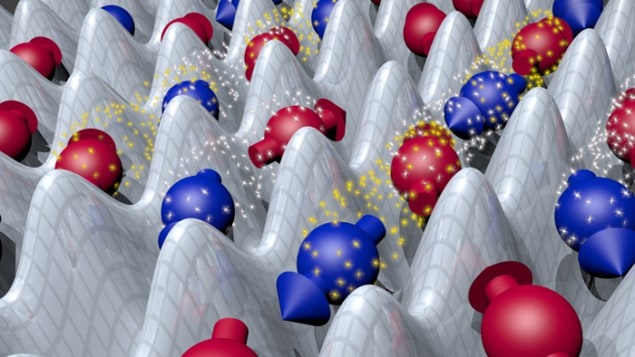
Quantum magnetism has been mimicked – or simulated – using ultracold fermionic atoms for the first time. Researchers in Switzerland and France placed atoms on a 2D square lattice created by criss-crossing laser beams. By controlling the interactions between atoms, the team put pairs of atoms into antiferromagnetic configurations. While quantum magnetism plays an important role in a range of solid-state phenomena, it can be difficult to calculate its effect on materials such as high-temperature superconductors. As a result, quantum simulations should lead to better theoretical models of a range of solids.
Quantum magnetism involves a subtle effect called the exchange interaction. This is a quantum interaction between pairs of identical fermions – such as electrons – that tends to prevent neighbouring fermions from having their spin magnetic moments pointing in the same direction. As well as being responsible for the magnetic properties of everyday materials such as iron, quantum magnetism is also believed to play an important role in high-temperature superconductivity and other exotic states of matter such as spin liquids.
Criss-crossing laser beams
Quantum simulations using ultracold atoms allow physicists to create artificial materials in which the atoms play the role of electrons in a solid. However, unlike real materials, where it can be difficult to vary the interactions between electrons, the forces between atoms in a quantum simulator can be fine-tuned by adjusting lasers and magnetic field.
These latest simulations were done by Tilman Esslinger and colleagues at ETH Zürich and the University of Bordeaux. The team began with an ultracold cloud of potassium-40 atoms, which are fermions. The cloud is a mixture in which half of the atoms are in the –9/2 spin state and the other half in the –7/2 state. This two-state system simulates –1/2 and 1/2 spin states of the electron. The criss-crossing laser beams are then switched on, creating a 2D square lattice wherein each lattice site contains one potassium-40 atom. The exchange interaction is then simulated by applying a magnetic field to the lattice, which makes atoms with the same spin repel each other.
The next experimental step involves solving a thermodynamics problem. Even at the extremely low lattice temperatures there is too much entropy – or disorder – for quantum magnetism to emerge. To get round this problem, Esslinger and colleagues came up with a way of “stashing” entropy at the edges of the lattice so that quantum magnetism could emerge in the centre.
This is done by tweaking the properties of the optical lattice so that the interactions between nearest-neighbour atoms alternate between strong and weak in the x and y directions. An atom with a strong interaction with a nearest neighbour will form a pair (or dimer) in which the spins point in opposite directions – and the lattice of 5000 atoms becomes a collection of antiferromagnetic dimers.
Merging dimers
Ideally, the next step would be to measure the spin of each atom in the lattice to confirm that antiferromagnetic dimers have formed; however, this would be extremely difficult to do. Instead, the team uses an indirect measurement technique that involves applying a magnetic-field gradient and merging each dimer into one lattice site. The team can then measure the number of lattice sites that contain two atoms and this information can be used to calculate the number of antiferromagnetic dimers that were present in the original lattice. When the strong and weak interactions were created, a strong majority of the atom pairs were antiferromagnetic dimers.
According to Esslinger, one feature of the quantum simulation is that its parameters are in a region where it is possible to perform calculations – and the team is collaborating with theorists with the aim of improving models of quantum magnetism. Esslinger also hopes that his team can address the entropy problem by creating an optical lattice with two layers and stashing entropy in the second layer.
“One of our next goals is to address unsolved questions in the context of spin liquids,” says Esslinger.
The research is reported in Science.



